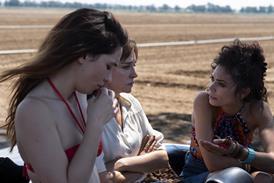The first film to shoot under the India-Germany co-production treaty, Anup Singh’s Qissa: The Tale Of A Lonely Ghost recently won the NETPAC award at the Toronto International Film Festival and is now screening in Busan’s A Window On Asian Cinema section.
Set in India following partition in 1947, the story revolves around a Sikh farmer, played by Irrfan Khan, who after being displaced from his land attempts to fight destiny; when his wife gives birth to yet another daughter, he decides to bring her up as a son. The cast also includes Tisca Chopra, Tillotama Shome and Rasika Dugal.
The Punjabi-language film was co-produced by Germany’s Heimatfilm, India’s National Film Development Corp (NFDC), the Netherlands’ Augustus Film and France’s Cine Sud. The Match Factory is handling international sales.
Born in Dar es Salaam, Tanzania, Singh made his directorial debut in 2002 with The Name Of A River, which played in around 30 film festivals and is available in the BFI’s DVD collection.
What inspired you to make this film?
It has a lot to do with stories – stories are still a token of exchange amongst a large section of people who were displaced, their children and their grandchildren. My grandfather was a refugee who moved from the Pakistan side to Dar es Salaam before partition. Conditions in that part of Punjab were already very violent and his parents were both killed.
These stories are everywhere – but there’s one that stayed with me and has a lot to do with this film. It was told to me by a very old man, who said that at the time of partition, women would simply jump into a well rather than be raped. His daughter, hardly a teenager, jumped into the well and he still dreams about it.
The film has a strong dreamlike quality. Was that intentional?
Very much so – with stories like these people always start by telling very real tales, but then veer off into the imaginary, as if to affirm that something else could have happened. I really wanted the quality of a fable without directly telling you that this is a fable. This film is personal on one level but it also deals with this wound in the memory of a nation that keeps on getting pricked and prodded. One of the main reasons to do this film was to see if there is another way to look at this wound.
How did you and the producers raise funding for the film?
The NFDC [India’s National Film Development Corp] read the script and almost immediately said they wanted to be part of the film. They helped me make my first film and they came in very early but we needed more finance for a film of this scale and with the way I wanted to make it. I met Johannes and Bettina [Johannes Rexin and Bettina Brokemper, Heimatfilm] in Rotterdam. Johannes was impassioned by the story and his determination and relentless following of every lead finally led to the other producers joining us.
Did you find it difficult working under the Indo-German treaty?
I think the difficulty for me was elsewhere. I felt completely assured by my producers that they were with me on script. However on any large co-production of this kind there are bound to be cultural gaps and trying to find a way to retain the spirit of the film took some time. There were certain aspects of the script that were not perhaps finding a fully translatable form in European terms so we had a lot of arguments about how to do the film. I was keen to have as much as possible from India, but a co-production of this nature doesn’t always allow for that.
The film pushes boundaries for India – do you think it will face problems with the Indian censors?
I’m very keen that the film is released in India so I shot the most harrowing scene, which features nudity, twice keeping India in mind. I wouldn’t say that was a compromise – I just found another way within the Indian aesthetic that allows the emotion of the character to stay alive. As for the subject matter and themes, I do hope there is some kind of debate about the wounds of partition and, given the kind of violence we’re seeing in India against women, films like this could bring these questions into the open and show us where we are going wrong.
Do you think India’s new wave of filmmakers are developing a unified aesthetic or do they all have different styles?
They’re all completely different because after a long time individuals are finally making films in India. Earlier we were overwhelmed by one kind of filmmaking because that was the only kind a producer would support. So even if people had different stories to tell, they would always fit them within a predetermined form. Now young filmmakers are finding support in group funding, in money from friends, in co-productions and realising that they can tell their own stories in exactly their own way.
What does Qissa mean?
It’s a Punjabi word with Arabic roots meaning fable or legend. In Punjab some of our most important love stories are called qissa and these stories have the same resonance in our culture as Romeo And Juliet has in the English world.

























No comments yet